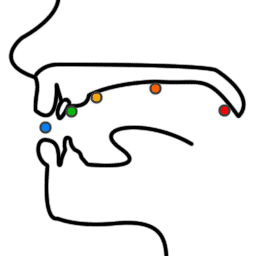Basic vowels
Sanskrit students traditionally begin their studies by learning about the different Sanskrit sounds. We will start our core lessons in the same way.
Why is it so important to study Sanskrit's sounds? It is because Sanskrit sounds often transform due to sound change rules. If we study Sanskrit's sounds closely, then we can better use and understand these sound change rules.
For that reason, half of our core lessons are about sounds: how to pronounce them, what they are like, and how they affect each other.
How do we make different sounds?
When we speak, a stream of air flows out of our lungs and through our mouth and nose. If we move our tongue, our lips, and other parts of our mouth, we can modify this flow of air and create different sounds.
Simple and open sounds like “a” and “o” are called vowels. When we pronounce them, our breath flows straight out of our mouths. And by moving our tongue and lips, we can create different vowel sounds: “Aaa! Eee! Ooo!”
The first Sanskrit vowel is a. a is a simple and relaxed sound:
- अ
a
Points of pronunciation
If we change the position of our tongue and lips, we can modify the basic vowel a and create other vowels.
How might we modify this sound? One way is by changing the point of pronunciation we use. Sanskrit sounds use five basic points of pronunciation, and you can see all five of them marked in the image below:

From right to left, these points are:
the soft palate, which is the soft and fleshy area at the back of your mouth
the hard palate, which is the hard and bony area that is sometimes called the “roof” of our mouth
the edge of the roof of the mouth, near the “hard bump” near our teeth
the base of our teeth
the lips
When we pronounce a, our tongue rests near our soft palate:
- अ
a
But if we change where our tongue rests in our mouth, we can create different vowel sounds. For example, we can move the middle of our tongue closer to the hard palate:
- इ
i
Or the tip of our tongue might rest near the bump on the roof of our mouth:
- ऋ
ṛ
Or the tip might rest near the base of the teeth:
- ऌ
ḷ
Or we might use our lips instead:
- उ
u
By using these five points of pronunciation, we create five different vowel sounds. And by changing our pronunciation in other ways, we can create many other kinds of sounds.
Review
In the next lesson, we'll combine the basic vowels above and create a variety of different sounds.
What are the five points of pronunciation?
What are the five vowels that we learned about in this lesson?